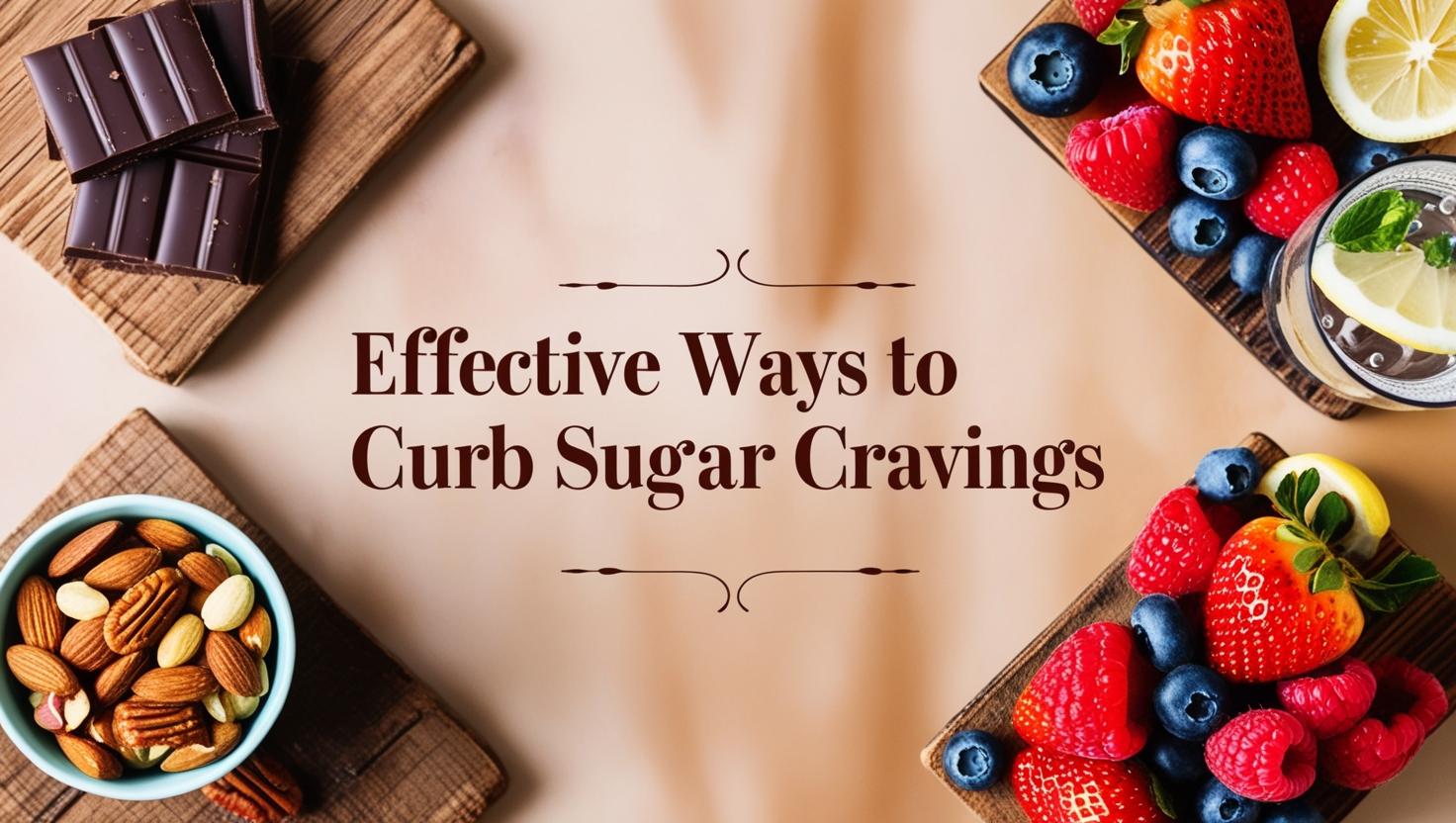Effective Ways to Curb Sugar Cravings

Understand Why You Crave Sugar
Cravings are a common struggle for many people. The average American adult consumes 22 to 30 teaspoons of added sugar daily. Understanding these cravings is key to managing them and practicing mindful eating.
Sugar’s Effect on the Brain
Sugar activates reward centers in your brain, releasing feel-good chemicals. This reinforces the craving for sweet treats, potentially leading to sugar addiction.
Research shows sugar triggers dopamine release. This motivates rewarding behaviors and contributes to you wanting to consume sugar.
The Role of Emotions in Sugar Cravings
Emotions play a significant role. Many turn to sweets when feeling stressed, depressed, or angry.
Low serotonin levels are linked to cravings and mood issues. Recognizing emotional triggers is crucial for managing cravings.
Practice mindful eating to develop healthier coping mechanisms. Regular exercise, proper sleep, hydration, and food journaling can help reduce the desire for sugar.

Satisfy Your Sweet Tooth in Moderation
Finding balance is key when managing sugar cravings. Enjoy small portions of treats while incorporating healthy snack alternatives and natural sugar substitutes. This approach helps maintain a nutritious diet.
Research shows that small servings of craved foods can prevent deprivation feelings. Aim for 150 calories and savor each bite. Try mixing treats with healthier options for added satisfaction.
Choose nutrient-dense treats that satisfy cravings and offer health benefits. Here are some examples:
- Dark chocolate with 70–85% cacao solids can be a healthier option for satisfying sweet cravings than regular chocolate.
- Natural sweeteners like stevia, honey, maple syrup, and agave nectar have a lower glycemic index compared to refined sugars, reducing the impact on blood sugar levels.
- High-fiber foods such as whole grains, legumes, fruits, and vegetables can help control sweet cravings by slowing down sugar absorption in the bloodstream.
Certain nutrient-rich foods can help curb sugar cravings. The table below shows some examples:
| Food | Nutrient | Benefit |
| Chia seeds | Fiber, omega-3 fatty acids | Reduces short-term food intake and increases satiety |
| Spinach | Thylakoids | Reduces hunger, increases satiety, and reduces cravings for palatable food |
| Lentils | Protein, fiber | Reduces postprandial glycemic response |
| Avocados | Healthy fats, fiber | Improves weight management and cardiometabolic factors |
Moderation is the key to satisfying your sweet tooth. Choose healthier treats and add nutrient-dense foods to your diet. This approach helps maintain a balanced lifestyle.

Combine Healthy Foods with Sweet Treats
Sugar cravings can be tough to resist. But you can satisfy your sweet tooth in healthier ways. Try combining nutritious foods with sweet treats for a balanced snack.
This approach curbs cravings and provides essential nutrients. It’s a smart way to enjoy sweets while nourishing your body.
Pairing Fruit with Chocolate
Fruits are natural sugar substitutes packed with vitamins and fiber. Pairing them with dark chocolate creates a satisfying, nutritious snack.
Dark chocolate, especially high-cocoa varieties, is rich in antioxidants. It may offer health benefits when eaten in moderation.
- Strawberries dipped in melted dark chocolate
- Banana slices topped with a drizzle of dark chocolate
- Apple wedges served with a small square of dark chocolate
Mixing Nuts with Chocolate Chips
Nuts are nutritious and can be combined with sweet ingredients. They’re packed with protein, healthy fats, and fiber.
Mix a handful of nuts with chocolate chips for a crunchy, sweet treat. This combo helps you feel full and satisfied.
| Nut | Chocolate Chip Type | Benefits |
| Almonds | Dark Chocolate Chips | Rich in vitamin E, magnesium, and fiber |
| Cashews | Milk Chocolate Chips | Good source of iron, zinc, and protein |
| Walnuts | Semisweet Chocolate Chips | High in omega-3 fatty acids and antioxidants |
Combining healthy foods with sweet treats lets you enjoy your favorite flavors. This approach provides essential nutrients while satisfying sugar cravings.
It’s a sustainable way to manage cravings long-term. You can indulge in moderation while maintaining a balanced diet.

Try a Sugar Detox
A sugar detox could help if you’re battling intense cravings. Cutting out simple sugars can reduce cravings and reset your taste buds. The first 48 to 72 hours may be tough, but cravings often subside after a few days.
Excess sugar intake can cause inflammation, raising risks for heart disease and high blood pressure.
- Swap sweetened drinks for water to reduce added sugar intake.
- Start your day with protein and fiber-rich foods.
- Read food labels to identify sneaky sources of added sugar in products.
- Eat high protein and high fiber foods.
- Stay hydrated by consuming water to help reduce cravings and overall calorie intake.
Books can guide you on reducing sugar and preparing low-sugar recipes. Your taste buds will adapt over time. You’ll soon need less sugar to feel satisfied.
| Duration of Sugar Detox | Potential Benefits |
| 1 week | Reduced cravings, improved energy levels |
| 2 weeks | Better sleep, clearer skin, improved digestion |
| 1 month | Stabilized blood sugar, weight loss, enhanced mental clarity |
Chew Gum to Combat Cravings
Chewing gum can curb cravings effectively. It keeps your mouth busy and distracts you from sweet treats.
Studies show that chewing gum can reduce food cravings, especially for sweets. One study using Sweet Victory gum had impressive results:
| Day | Percentage of Participants with Reduced Sugar Cravings |
| Day 1 | 53% |
| Day 4 | 79% |
In this study, 87% of participants lost weight, averaging 1.3kg over two weeks. 80% reported eating fewer sweets and feeling more in control of their food choices.
University of Rhode Island researchers found gum chewers ate 68 fewer calories at lunch. Small calorie savings add up over time. Replacing chips with gum once weekly could lead to two pounds lost yearly.
To maximize gum’s effectiveness against cravings, chew until it loses its taste. Sugar-free gum is better, containing less than 5 calories per piece.
Use gum in moderation. Excessive consumption of sorbitol-containing gum may cause digestive issues. Alternate gum with hard candy to reduce bloating from swallowing air.

Reach for Fruit Instead of Candy
Sugar cravings? Grab a piece of fruit. Fruits are sweet and packed with fiber, vitamins, and antioxidants. Keep fresh or frozen fruits handy for healthy snack alternatives.
Fruits offer many benefits over candy and sugary treats. In the 1700s, people ate six pounds of sugar yearly. Today, we consume 150 pounds annually, mostly from processed foods.
This sugar overload causes health problems like obesity and diabetes. It also leads to oxidative stress and glycation in the body.
The Benefits of Fiber and Nutrients in Fruit
Fruit has fiber, which candy lacks. Fiber-rich foods improve blood sugar levels compared to low-fiber diets. It slows sugar absorption, preventing energy spikes and crashes.
Fruits also contain essential nutrients like vitamins A and C. These nutrients, along with potassium and antioxidants, support overall health.
Try berries, citrus fruits, apples, and pears. These fruits are tasty and offer satisfying textures. Frozen fruits can mimic ice cream while providing nutrition.
By eating more fruits, you’ll manage cravings better. You’ll also enjoy natural sugar substitutes and valuable nutrients.
Distract Yourself from Cravings
Sugar cravings can be tough to resist. Distracting yourself can help beat these urges and promote mindful eating. Taking a walk and changing your scenery is a simple yet powerful technique.
Research shows brief physical activity can reduce cravings for sugary snacks. A 15-minute walk can shift your focus and let the craving pass. This works especially well for overweight individuals.
Other distracting activities can also help. Try watching a video, calling a friend, or enjoying a hobby. Find an activity that captures your attention and helps you forget about the craving.

The Power of Mindfulness in Managing Cravings
Mindfulness practices like mindful eating can significantly reduce sugar cravings. A study found it decreased binge eating episodes from 4 to 1.5 per week. Being present helps you understand your cravings better.
| Distraction Technique | Effectiveness |
| 15-minute walk | Reduces cravings for sugary snacks |
| Engaging in a hobby | Shifts focus away from cravings |
| Mindful eating | Reduces binge eating episodes |
Over half of people experience regular cravings. These urges often hinder weight loss and maintenance. Using distraction techniques and mindfulness can help you manage sugar cravings effectively.
Choose Quality Over Quantity
Satisfying your sweet tooth with quality treats can be a game-changer. Savor a small portion of a decadent treat instead of a large candy bar. This mindful eating approach lets you indulge without consuming excessive sugar.
Opting for Small, Decadent Treats
Curb sugar cravings by choosing a small, luxurious treat over a larger one. A single dark chocolate truffle can be more satisfying than a king-sized candy bar.
Savor each bite slowly, experiencing the rich flavors and textures. This quality-focused approach satisfies cravings without needing excessive sugar.
| Large Candy Bar | Small Dark Chocolate Truffle |
| High in sugar and calories | Lower in sugar and calories |
| Often consumed quickly | Savored slowly and mindfully |
| May lead to overconsumption | Satisfies cravings with a smaller portion |
Transform your relationship with sweets by choosing quality over quantity. A small portion of delicious treats can be more satisfying than mediocre sweets.
Embrace healthy snack alternatives by selecting high-quality, portion-controlled options. This approach aligns with health goals while allowing occasional indulgences.

Eat Regular, Balanced Meals
To curb sugar cravings, eat balanced meals throughout the day. Skipping meals can lead to intense hunger and poor food choices. Aim to eat every 3 to 5 hours to keep blood sugar levels stable.
Include protein, fiber-rich foods, and complex carbohydrates in your meals. Protein sources like meat, poultry, fish, or lentils can help. These options reduce hunger-driven cravings throughout the day.
Add nutrient-dense foods to your meals to combat sugar cravings. Here are some options:
- Dates: Despite their high sugar content, dates can reduce cravings and improve cholesterol levels in diabetics.
- Dark chocolate: Contains less sugar than milk chocolate and may improve cognitive and heart health.
- Berries: Rich in fiber and antioxidants, berries offer sweetness while reducing disease risk factors.
- Yogurt: Options with live cultures and no added sugar can regulate appetite and control cravings.
- Sweet potatoes: A nutritious carb source that can help combat cravings and add calories to meals.
- Chia seeds: High in omega-3 fatty acids and fiber, chia seeds keep you full longer.
Include these foods in your meals to manage cravings effectively. Consistency is crucial for maintaining a healthier, low-sugar diet. Regular, balanced meals will help you achieve your health goals.

How to Cut Sugar Cravings by Rethinking Your Drinks
Sodas, fruit juices, and flavored coffees can be major sources of added sugars. These drinks fuel cravings and may lead to health issues. A 12-ounce can of regular soda contains nearly 10 teaspoons of sugar.
Choose healthier drinks like water, sparkling water, or unsweetened tea. These options help you avoid added sugars and keep you hydrated. Proper hydration is key to reducing mistaken hunger cues that cause sugar cravings.
Avoiding Sugary Beverages
Drinking water before eating can reduce hunger and sugary food consumption. Women need about 9 cups of water daily, while men need 13 cups. Replacing sugary drinks with water can greatly decrease your sugar intake.
Choosing Water or Sparkling Water Instead
Make plain water more appealing by adding lemon, lime, or cucumber slices. Sparkling water offers a refreshing fizz without extra calories or sugar. Over time, your taste buds will adjust to less sweet drinks.
Avoid Artificial Sweeteners and Reward Yourself
Artificial sweeteners may not help. Studies show they haven’t significantly impacted the obesity epidemic.
Celebrate each milestone to reinforce your commitment to a healthier lifestyle. Treat yourself to a relaxing bath or a new book after a sugar-free week. Non-food rewards can keep you motivated on your low-sugar journey.
Too much sugar can cause health problems like metabolic syndrome and liver damage. It can also lead to insulin resistance, diabetes, and heart disease. Breaking free from sugar addiction helps you enjoy a balanced, nutritious diet.
Be aware of factors that trigger sugar cravings. Afternoon circadian rhythm changes and magnesium deficiency can contribute. Understanding these triggers helps you find healthy coping strategies.
By addressing cravings and avoiding artificial sweeteners, you can maintain a low-sugar diet. This approach supports a healthier lifestyle in the long run.
